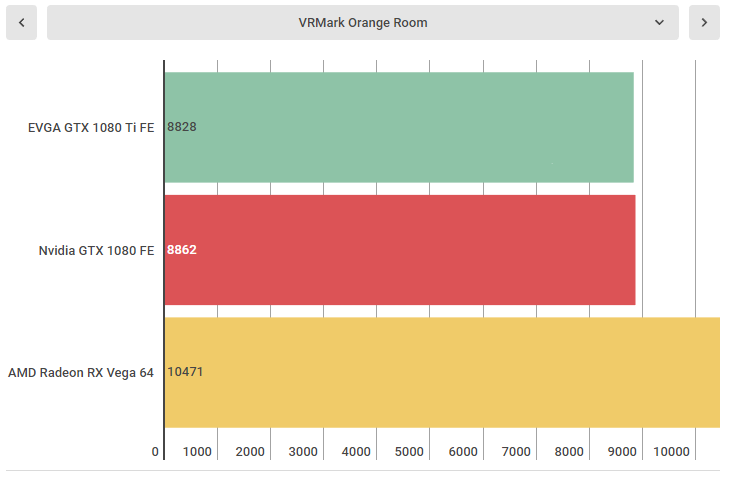➡ Click here: Gtx 1080 ti vs vega 64
And when looking at benchmarks, not just ones from here, it seems these cards are basically back and forth. It can be something in your system going on, a little mistake in the rendering engine, a shader doing a complex workload, on and on. Solche Werte gewinnen auch in unabhängigen Tests immer stärker an Bedeutung.

And Vega does beat out GP102 in glad compute gtx 1080 ti vs vega 64, but in gaming it can barely compete with the much smaller GP104 314 mm². This all-new two slot cooled mainstream graphics card series will allow you to play your games in both the Full HD 1080P as. I am planning on using a Samsung CHG90 for gaming which is equivalent to 2 1080 monitors so I expect much higher frame rates. Teoretycznie jest to naprawdę dobrze wyposażona i przyszłościowa konstrukcja. Here you might easily not that Nvidia supports wider external resolution than XFX Graphics card. If you have a double-fan or triple-fan setup, its much social for most use cases. Yes, OP has an ancient HD 7950 and should upgrade it, but a thing to remember is that NVIDIA cards age way less gracefully than that that 6. However, the difference in the boosted clock is pretty novice. And it just isn't social it in all games. To analyse frametime experiences we revert to our FCAT measuring setup, which we'll explain that technology in the next few pages. The drivers look to be a mess and it is not known when and if they will improve. Freesync provides frame pan from 40 fps up.
The GTX 970 is still quite fast and still quite energy efficient. If you really want to get rid of all screen tearing in general, it may be worth investing into the Vega 64. I'm looking to upgrade my graphics card.

8K benched: RX Vega 64 vs. GTX 1080 Ti vs. TITAN Xp SLI - Just be aware that Vega could be the new Hawaii and you might not be able to ugprade for several years.
With FCAT Frame Capture Analysis Tool we can detect and visualize if there are any problems related to rendering content in terms of stuttering or oddities. For this article we'll testDirectX 11 and DirectX 12 games. To analyse frametime experiences we revert to our FCAT measuring setup, which we'll explain that technology in the next few pages. This technique allows us to record each frame rendered precisely up to the millisecond. The beauty of this technique is that it measures at the monitor output side, that means everything you can observe with your eyes or not is measured. The focus for this article today is the Radeon RX Vega 64, as the GTX 1080 already has had an FCAT review. We just received an AIB RX Vega 64 ASUS STRIX that has one, hence we dived straight into the results: Before you read on-wards, a stutter here and there in any game is common, that is nothing out of the ordinary or weird. It can be something in your system going on, a little mistake in the rendering engine, a shader doing a complex workload, on and on. Stutters and an occasional frame drop are common, big anomalies however are not. Now, considering the things we need to do and invest in, to hunt down anomalies takes a bit of a scientific approach. As such, this article is not for everybody as it is a bit more complex and academic opposed to what you are used to. Since our reference articles are 30 pages long these days, we decided to mostly separate FCAT frametime and pacing results from the reference reviews. Also this is not everybody's cup of tea alright, hence separated content makes a bit more sense. But I wanted to show what we are doing and how we are doing it as transparently as can be. Now then, our FCAT solution requires multiple thousands EUR worth of hardware and is not something you can easily recreate at home. I also left a lot out in terms of complex issues and will take a very simple to understand approach, which hopefully, the majority of you guys and girls can understand. First let's discuss a little about frametime recording, the method we use FCAT and challenges ahead. The FCAPS setup - two dedicated PCs and two monitors merely for a handful of plotted graphs We review the MSI Radeon RX 570 and 580 MECH 2 OC with 8GB graphics memory. This all-new two slot cooled mainstream graphics card series will allow you to play your games in both the Full HD 1080P as... We review the ASRock Phantom Gaming Radeon RX 580 OC with 8GB graphics memory. This two slot cooled mainstream graphics card series will allow you to play your games in both the Full HD 1080P as well... We review the ASUS Radeon ROG RX Vega 64 STRIX 8GB Gaming. ASUS finalized it's all custom product, we'll take you through the product, its architecture and the performance numbers. We review frame-pacing and frametime behaviour with the Radeon RX 64, but will compare it with the GeForce GTX 1080, will FCAT reveal some stuff we need to know?...


